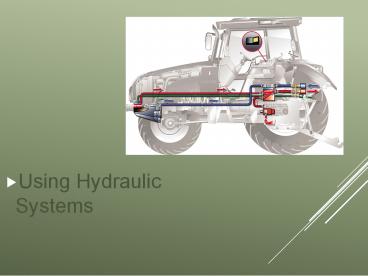Using Hydraulic Systems - PowerPoint PPT Presentation
1 / 26
Title:
Using Hydraulic Systems
Description:
Title: Central Core CD Author: Valued Gateway Client Last modified by: Purcella, Leslie Created Date: 1/19/2002 4:31:35 PM Document presentation format – PowerPoint PPT presentation
Number of Views:655
Avg rating:5.0/5.0
Title: Using Hydraulic Systems
1
- Using Hydraulic Systems
2
Next Generation / Common Core Standards Addressed!
- CCSS.ELA Literacy RST.9 10.1 Cite specific
textual evidence to support analysis of science
and technical texts, attending to the precise
details of explanations or descriptions. - CCSS.E L A Literacy RST. 11-12.1 Cite specific
textual evidence to support analysis of science
and technical texts, attending to important
distinctions the author makes and to any gaps or
inconsistencies in the account. - CCSS.ELA Literacy.RST.9-10.3 Follow precisely a
complex multistep procedure when carrying out
experiments, taking measurements, or performing
technical tasks, attending to special cases or
exceptions defined in the text. - CCSS.E LALiteracy.RST.11-12.3 Follow precisely a
complex multistep procedure when carrying out
experiments, taking measurements, or performing
technical tasks analyze the specific results
based on explanations in the text
3
Student Learning Objectives / Bell Work!
- Define hydraulics and explain its major operating
systems. - Discuss the basic principles of hydraulics.
- Describe the primary components of a hydraulic
system. - Describe the advantages and disadvantages of
hydraulic systems.
4
Terms
- Hydraulic actuator
- Hydraulics
- Hydrodynamics
- Hydrostatics
- Law of Conservation of Energy
- Linear actuator
- Connectors
- Cycle time
- Directional control valve
- Energy
- Filter
- Flow rate
5
Terms (continued)
- Micron
- Multiplication of force
- Pascals Law
- Piping
- Positive displacement pump
- Pressure gauge
- Pressure relief valve
- Prime mover
- Pump
- Reservoir
- Rotary actuator
- Strainer
6
Interest Approach
- Have you ever used a floor jack or driven an
automobile equipped with power brakes or power
steering?
7
Hydraulics
- A branch of physics dealing with the mechanical
properties and practical applications of fluids
in motion - Hydraulic systems do not create power. They
transfer power from an outside source - Prime mover the outside source of power
8
Hydrodynamics
- The use of liquids at high flow and low pressure
to perform work
9
Hydrostatics
- Use of liquids at high pressure and low flow to
perform work
10
Pascals Law
- Pressure applied to a confined fluid is
transmitted undiminished in all directions
11
Application of Pascals Law
12
Multiplication of force
- The hydraulic system takes a small input force
and transforms it into a larger output force
13
Cycle time
- The amount of time required for one complete set
of operations to occur. - Flow rate the measure of how many gallons per
minute of hydraulic fluid would run into a
container.
14
Law of Conservation of Energy
- Energy may be changed from one form to another,
but it cannot either be created or destroyed - Energy the capacity to do work
15
Components of a hydraulic system
- Reservoir supplies oil to the hydraulic pump
and stores oil that returns after passing through
the hydraulic circuit - Strainer directs the hydraulic oil in a
straight line through an element made of metal
screens attached to a metal core - Filter directs hydraulic oil through one of
more layers of a porous elements that may trap
particles - Micron equal to 39 millionths of an inch
16
Primary components of a hydraulic system
17
Components (continued)
- Pump causes hydraulic oil to flow through the
circuit - Positive displacement pump delivers the same
volume of oil per cycle regardless of the
pressure at the pump outlet - Pressure gauge measure and shows the pressure
being produced in a hydraulic system.
18
Abourdointubepressuregauge
19
Components (continued)
- Directional control valve controls the
operation of the systems cylinder sand motors by
direction the flow of the fluid in the system
20
Primary parts of a typical cylinder
21
Components (continued)
- Hydraulic actuator converts fluid energy into
mechanical energy - Linear actuator the output of the cylinder
occurs in a straight-line manner - Rotary actuator produces a rotating output force
22
Components (continued)
- Piping fluid conducting lines that connect
various components of a hydraulic system - Connectors used to join one piece of piping to
another, or to hydraulic system components
23
Advantages of hydraulic systems
- Increased flexibility
- Variable speed
- Multiplication of force
- Reduced wear
- Reversibility
24
Disadvantages of hydraulic systems
- High pressure
- Need for cleanliness
- Safety hazards
25
Review/Summary
- What is hydraulics and what are its major
operating systems? - What principles govern the use of hydraulics?
- What are the primary components of a hydraulic
system? - What are the advantages and disadvantages
associated with hydraulic systems?
26
The End!































